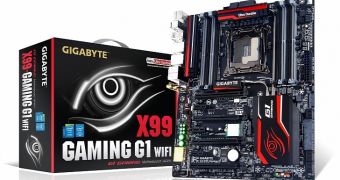You may or may not recognize the X99 chipset as the one that will welcome the Haswell-E line of top-tier central processing units from Intel, when they launch in a month or two.
The core-logic pulls out all the stops when it comes to driving performance high. It has to, in order to keep up with the likes of the Core i7-5960X, Core i7-5930K, and Core i7-5820K.
Gigabyte hasn't officially launched the X99 Gaming G1, but it probably will soon. Until then, it has given us the photo up on the right to look at.
Through it and the blog post it was published in, we also get to learn the basic specifications of the platform. No doubt there are a whole bunch of overclocking and other technologies all over the place, but for now we have just the more obvious hardware components to share with you.
First off comes, of course, the LGA 2011-3 socket, which happens to be wired to no fewer than eight DDR4 DIMM memory slots.
That means you can install up to 64 GB of quad-channel DDR4 memory on this thing, which is a lot by any standards. Especially when you consider the low power draw of 1.2V.
Ten SATA 6.0 Gbps ports can also be seen, making for a truly ludicrous top storage capacity, especially if you use one of those new 6 TB or 8 TB HDDs.
A SATA Express port is available as well, allowing compatible SSDs and HDDs to use up to 10 Gbps bandwidth. Eventually there will be more 12 Gbps ports, but for now 10 Gbps is what you get.
There is an M.2 slot as well, for small SSDs, and we can only hope that it is wired through PCI Express rather than SATA tech. Otherwise, speed will be limited to 500-600 MB/s instead of reaching 1.8 GB/s or more.
Gigabit Ethernet is present as well, obviously (Qualcomm Killer E2200), along with 802.11 ac WLAN, Bluetooth 4.0, and Sound Core3D audio (with user-replaceable headphone amp and ground-layer isolation). USB 3.0 and USB 2.0/1.1 ports exist as well, in significant number.
Finally, there are four PCI Express 3.0 x16 slots on the graphics adapter, though they cannot all be used at full power at once. Here are the combinations: x16/NC/x16/NC or x16/NC/x8/x8 or x8/x8/x8/x8. Either way, they make for very good quad-SLI or CrossFire multi-GPU configurations.

 14 DAY TRIAL //
14 DAY TRIAL //